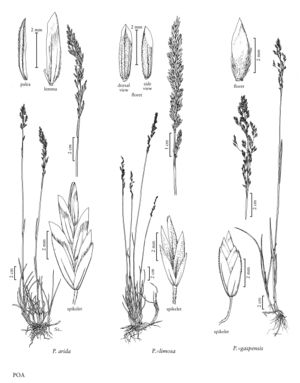Plants perennial; densely to loosely tufted or the culms solitary, shortly rhizomatous. Culms 20-80 cm, erect or the bases decumbent. Sheaths usually closed for about 1/6 their length; ligules 1-4 mm, smooth or sparsely scabrous, apices obtuse to acute; innovation blades 0.5-2 mm wide; cauline blades 0.5-5 mm wide, flat, folded, abaxial surfaces smooth or scabrous, apices narrowly prow-shaped. Panicles 5-15 cm, erect, usually contracted, sometimes interrupted; branches shorter than 4 cm, erect, angles somewhat scabrous. Spikelets 4-7 mm, weakly laterally compressed; florets 2-5; rachilla internodes smooth. Lower glumes 3-veined; calluses glabrous or webbed, hairs to 1/4 the lemma length; lemmas 2.5-4.5 mm, narrowly lanceolate, distinctly to weakly keeled, glabrous throughout or the keels and marginal veins sparsely long-villous, apices acute; palea keels scabrous; anthers aborted late in development or 1.3-2.2 mm. 2n = 64.
Distribution
Alta., B.C., Sask., Calif., Oreg.
Discussion
Poa xlimosa grows at scattered locations in western North America. It prefers wet to moist, often saline or alkaline meadows, primarily in the sagebrush zone. It is probably a hybrid between P. pratensis (p. 522) and P. secunda subsp. juncifolia (p. 586). Vigorous artificial hybrids of this parentage have been produced; they resemble P. xlimosa.
Poa ×limosa is a named intersectional hybrid
Selected References
None.
